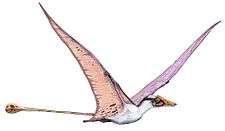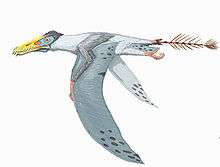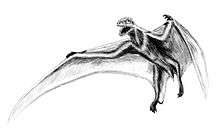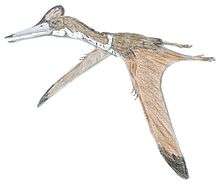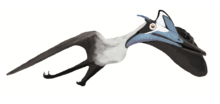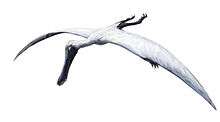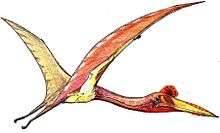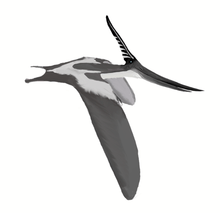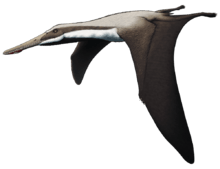Cathayopterus
Cathayopterus is a ctenochasmatid pterosaur from the Early Cretaceous-age Yixian Formation of Liaoning, China. The name means "China wing", using the word "Cathay" as an old alternative name for China. The type species is C. grabaui, described in 2006 by Wang Xiaolin and Zhou Zhongh. It is a member of the Ctenochasmatidae, a clade of mostly filter feeding pterosaurs from the Jurassic and early Cretaceous.[1][2]
| Cathayopterus | |
|---|---|
| Scientific classification | |
| Kingdom: | Animalia |
| Phylum: | Chordata |
| Order: | †Pterosauria |
| Suborder: | †Pterodactyloidea |
| Family: | †Ctenochasmatidae |
| Genus: | †Cathayopterus Wang & Zhou, 2006 |
| Type species | |
| †Cathayopterus grabaui Wang & Zhou, 2006 | |
Description
Cathayopterus is only known from a skull preserved in dorsal view, which shows teeth splaying outwards at the tip of the rostrum, similar to Ctenochasma. The skull is incomplete, with the left side being damaged.[1]
Paleobiology
Cathayopterus was likely a filter feeder, just like other ctenochasmatid pterosaurs. It likely roamed around waterways to feed.[1]
References
- Wang, Xiaolin & Zhou, Zhonghe (2006). "Pterosaur assemblages of the Jehol Biota and their implication for the Early Cretaceous pterosaur radiation". Geological Journal. 41 (3–4): 405–418. doi:10.1002/gj.1046.
- Wang, Xiaolin & Zhou, Zhonghe (2006). "Pterosaur adaptational radiation of the Early Cretaceous Jehol Biota". In Rong, Jiayu; Fang, Zongjie; Zhou, Zhonghe; et al. (eds.). Originations, Radiations and Biodiversity Changes—Evidences from the Chinese Fossil Record. Beijing: Science Press. pp. 665–689, 937–938.
